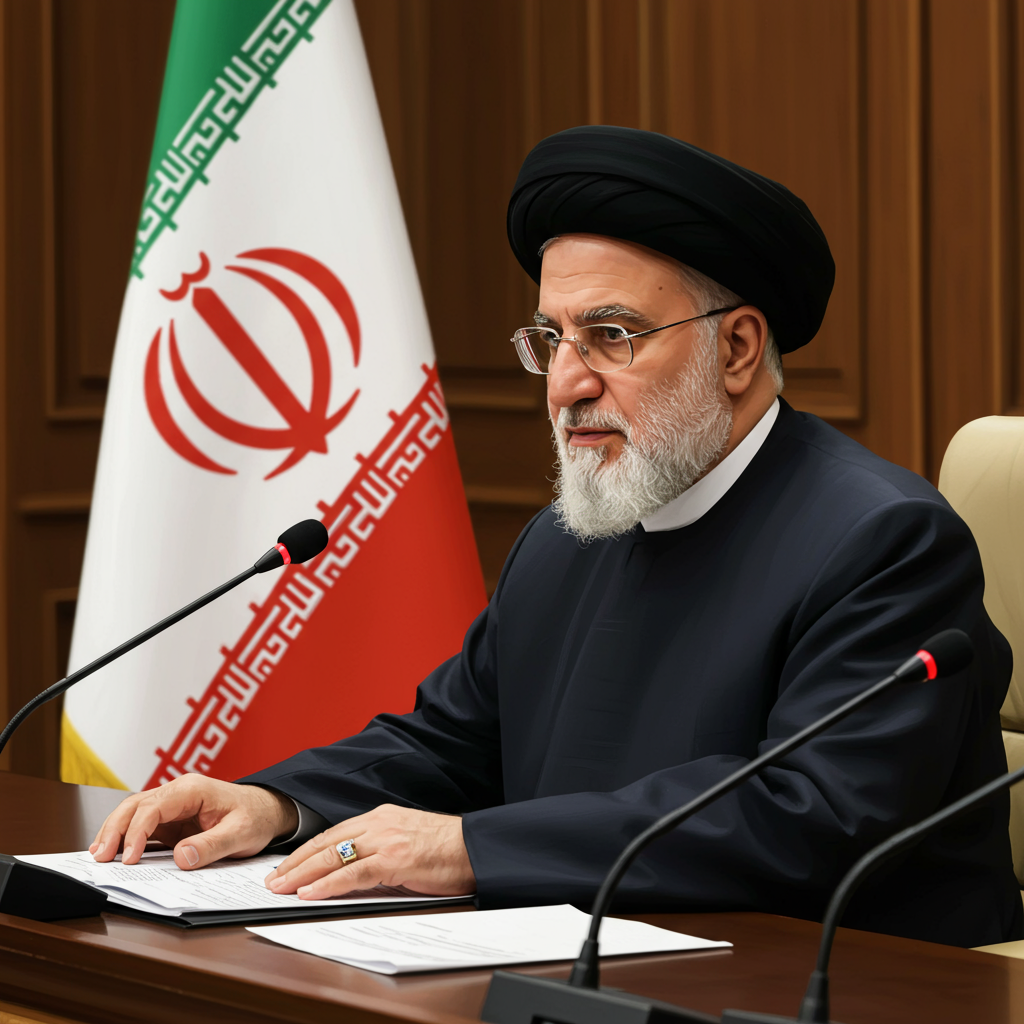A compelling report emerging from Iran claims President Masoud Pezeshkian suffered injuries during a recent Israeli strike inside the country. According to Iran’s state-affiliated Fars news agency, the incident occurred last month amidst a heated, brief military confrontation between the two regional adversaries. The alleged attack specifically targeted a clandestine meeting of Iran’s top leadership, underscoring the intensity and reach of the conflict.
Alleged Strike Targets Secret Leadership Meeting
The Fars news agency, described as being close to Iran’s powerful Revolutionary Guard, detailed the purported events of June 16. On this date, Israeli forces reportedly launched an attack targeting a secret underground facility located in western Tehran. At the time of the strike, Iranian President Masoud Pezeshkian was reportedly attending an emergency session of the Supreme National Security Council (SNSC). The SNSC serves as Iran’s foremost decision-making body, second in authority only to Supreme Leader Ayatollah Ali Khamenei.
The Fars report asserts that Israel deployed six bombs or missiles during the operation. These munitions allegedly struck the access and entry points of the fortified facility. The primary objective, according to the report, appeared to be trapping the high-level officials inside. The strikes reportedly succeeded in blocking all six entry and exit routes. They also allegedly disabled the facility’s ventilation system. Additionally, the electricity supply to the underground bunker was cut off, plunging those inside into darkness and difficult conditions.
Escape and Injuries
Faced with the blocked exits and deteriorating conditions, President Pezeshkian and others present reportedly sought escape through an emergency shaft or hatch. It was during this desperate egress that President Pezeshkian is said to have sustained injuries. The report specifically mentions leg injuries suffered by the president as he navigated the emergency escape route to reach safety. Multiple other officials present at the meeting also reportedly suffered minor injuries while fleeing the targeted facility. Besides President Pezeshkian, other key figures reportedly in attendance included Parliament Speaker Mohammad Bagher Ghalibaf and Judiciary Chief Gholam-Hossein Mohseni-Eje’i.
Videos shared on social media during the “12-day war” reportedly showed repeated strikes against a mountainside in north-western Tehran. It has since emerged, according to these Iranian reports, that those strikes on the fourth day of the conflict specifically targeted this secret underground facility housing Iran’s top leaders.
Context of the Intense 12-Day Conflict
The alleged strike on President Pezeshkian occurred within the broader timeframe of a sharp, albeit brief, military confrontation between Israel and Iran. This 12-day conflict ignited on June 13 with a surprise Israeli attack on Iranian soil. Israel stated its primary motivation was to prevent Iran from developing nuclear weapons, striking various nuclear and military installations across the country.
The initial Israeli offensive reportedly caught Iranian leaders completely off guard. Iranian officials later admitted they were taken by surprise. This surprise reportedly led to a period of decision-making paralysis lasting at least the first 24 hours of the conflict. During these critical initial hours, Israeli forces were reportedly highly effective. They allegedly targeted and eliminated numerous top commanders from Iran’s Islamic Revolutionary Guard Corps (IRGC) and regular army. Notable figures reported killed on the first day of strikes included IRGC chief Maj Gen Hossein Salami and Iranian armed forces chief of staff Maj Gen Mohammad Bagheri.
Israeli officials also reportedly confirmed that Iran’s Supreme Leader, Ayatollah Ali Khamenei, was among their targets. However, they reportedly lost track of him after he was moved to a secure, secret location, which was largely isolated from external communications.
Intelligence Breach and Infiltration Suspicions
The precision and effectiveness of the Israeli strikes, particularly the alleged attack on the secret SNSC meeting, have raised significant questions regarding intelligence gathering. Iran is now reportedly following leads suggesting potential infiltration by Israeli agents. The uncanny accuracy of the strike on the specific location and timing of a clandestine high-level meeting strongly suggests that Israel obtained critical intelligence. Iranian authorities are reportedly investigating whether a “mole” or covert agents leaked information about the meeting’s whereabouts and schedule.
Both Iran and Israel have acknowledged that Israeli covert operations involving agents on the ground have occurred in the past. Following the recent conflict, Iran reportedly initiated a severe crackdown on suspected Mossad agents and affiliates within the country. This has reportedly resulted in numerous arrests and executions of individuals accused of espionage. Some reports even suggest the method used in the alleged attack on the Tehran facility mirrored the tactic employed in Beirut that resulted in the death of Hezbollah leader Hassan Nasrallah the previous September.
President Pezeshkian’s Public Claims
Adding further weight to the reports of a targeted attack, President Pezeshkian himself publicly stated that Israel had attempted to assassinate him. Speaking in a recent interview via video call with American political commentator Tucker Carlson, Pezeshkian directly addressed the matter. He unequivocally claimed, “It was Israel” that attempted the assassination, specifically denying any involvement by the United States.
Pezeshkian described the incident during the interview, stating, “I was in a meeting, we were discussing how to move forward.” He attributed the targeting of their location to intelligence gathered by Israeli spies. “Thanks to their spies, they tried to bomb the area where we were gathered,” he told Carlson. While he did not specify the exact date of this attempt in the interview, the Fars news agency report linking his injury to the June 16 strike on the SNSC meeting places his claim in specific context. Pezeshkian also included a statement of personal faith during the interview. He asserted his belief that “only God Almighty determines when a person lives or dies” and expressed his willingness to “sacrifice myself to defend the country.”
Accusations and Denials
Official responses to the reported injury and alleged targeting remain largely unverified or consist of denials. Israel has not publicly commented on the Fars news agency report regarding President Pezeshkian’s injury. Israeli Defence Minister Israel Katz previously denied that “regime change” was a goal of their actions during the war, responding to earlier accusations by Pezeshkian that Israel was trying to kill him.
During his interview with Tucker Carlson, President Pezeshkian also addressed Iran’s controversial nuclear program. He firmly denied that Iran is developing nuclear weapons. “We have never pursued the development of a nuclear bomb,” he stated, asserting this applies to the past, present, and future. He cited religious prohibitions, specifically fatwas issued by Supreme Leader Ali Khamenei, as the reason why nuclear weapons are religiously forbidden for Iran. Pezeshkian also accused Israeli Prime Minister Benjamin Netanyahu of promoting a “false narrative” about Iran seeking a nuclear bomb, claiming Netanyahu has pushed this narrative since 1984.
Broader Scope of the Conflict
The 12-day conflict also saw significant retaliation from Iran. Iran reportedly responded to the initial Israeli strikes by launching a large barrage of aerial attacks. These included reports of over 500 missiles and more than 1,100 drones targeting Israeli cities and military installations.
Furthermore, the United States became directly involved in the latter stages of the conflict. On June 22, the US Air Force and Navy reportedly carried out air and missile strikes against three Iranian nuclear facilities. Targets reportedly included sites at Natanz, Fordo, and Isfahan, utilizing specialized munitions like “bunker-busting” bombs and Tomahawk missiles. US President Donald Trump later claimed these attacks had “obliterated” the facilities, although some US intelligence agencies reportedly offered a more cautious assessment of the damage inflicted.
The conflict ultimately concluded with a ceasefire, reportedly brokered by the United States. Despite the cessation of hostilities, many questions persist regarding the events that transpired, particularly concerning the depth of Israeli intelligence capabilities and the reported targeting of Iran’s most senior political and military figures. The unverified report of President Pezeshkian’s injury serves as a stark reminder of the high stakes and precarious nature of the ongoing tensions between Iran and Israel.
Frequently Asked Questions
What reportedly happened during the alleged Israeli strike on June 16?
According to a report by Iran’s Fars news agency, Israeli forces allegedly struck a secret underground facility in Tehran on June 16. Iranian President Masoud Pezeshkian and other top officials were reportedly attending an emergency meeting of the Supreme National Security Council there. The strike allegedly used six bombs or missiles to target entry and exit points, aiming to trap those inside. It reportedly cut power and ventilation. Officials reportedly escaped through an emergency shaft, and President Pezeshkian allegedly suffered leg injuries during the escape.
Where was the secret facility reportedly located?
The secret underground facility targeted in the alleged June 16 strike was reportedly located in western Tehran. Social media videos from the time of the 12-day conflict showed repeated strikes against a mountainside in the north-western part of the city, which these reports now claim corresponded to the location of this specific facility used by Iran’s top leaders for clandestine meetings.
What other high-ranking officials were reportedly targeted by Israel during the conflict?
Beyond the alleged targeting of President Pezeshkian and other SNSC members during the June 16 strike, Israeli forces reportedly targeted numerous high-ranking Iranian figures during the 12-day war that began on June 13. Initial Israeli strikes were said to have killed many top IRGC and army commanders, including specific figures like Maj. Gen. Hossein Salami and Maj. Gen. Mohammad Bagheri on the first day. Israeli officials also reportedly admitted that Supreme Leader Ayatollah Ali Khamenei was a target, though they lost track of him after he was moved.
Conclusion
The report from Iran’s Fars news agency, claiming President Masoud Pezeshkian was injured during an Israeli strike on a secret facility, highlights the extraordinary reach and intensity of the recent conflict. While the report remains unverified by independent sources and Israel has issued no public comment, the details provided paint a vivid picture of a targeted attack aimed at the highest levels of Iranian leadership. Coupled with President Pezeshkian’s own public assertion of an assassination attempt and the reported elimination of top military commanders, the incident underscores the sophisticated intelligence capabilities allegedly employed by Israel and the significant security challenges facing Iran. As Iran continues its investigation into potential infiltration, the event serves as a critical moment in the escalating shadow war between the two nations.



